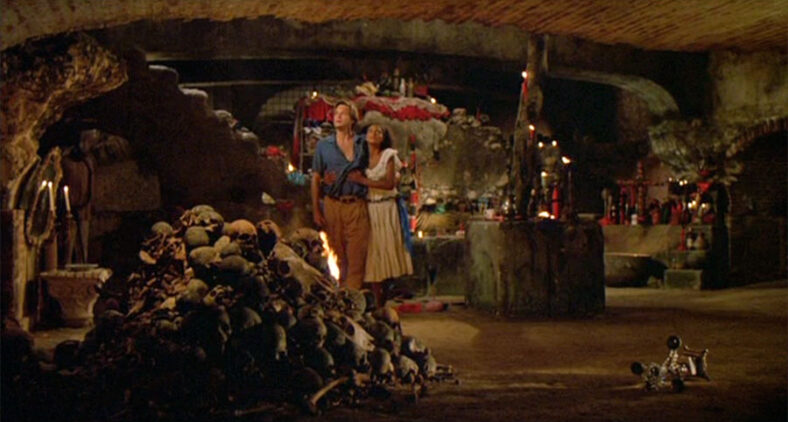This Surreal Zombie Flick Inspired by a True Story Is The Ultimate Forgotten Wes Craven Chiller

Like nearly every other horror fan I know, I count Wes Craven as one of my favorite filmmakers. The Scream director knew how to scare the pants off of the moviegoing public. And he knew how to portray relatable characters on the silver screen. Both of the previous claims are true of his 1988 horror film The Serpent and the Rainbow. Yet the picture remains largely forgotten by the masses. Although the film is not representative of Craven’s best output, it’s nonetheless a solid effort that delivers a level of subtext, compelling characters, and plenty of good old-fashioned scares. Seeing as the film observes a release date anniversary this week, there is no time better than the present to pay the picture a repeat visit.
The setup for Wes Craven’s The Serpent and the Rainbow is this:
Anthropologist Dr. Dennis Alan (Bill Pullman) visits Haiti at the behest of a pharmaceutical company. He’s there to research a drug called tetrodotoxin that reportedly transports people to a liminal space between life and death. At the time of Dennis’ visit, the country is dealing with political oppression from a dictatorial regime. One of the key players in that very regime also happens to be a powerful voodoo priest (an oungan) called Peytraud (Zakes Mokae). Peytraud uses tetrodotoxin to keep the locals under his thumb by taking control of their minds and bodies. Dennis teams up with Dr. Marielle Duchamp (Cathy Tyson) to investigate the experimental substance for use as a natural alternative to anesthesia and search for so-called zombies. Their quest displeases the oungan greatly. Surreal chaos subsequently ensues.
I think one reason The Serpent and the Rainbow (which is based on Wade Davis’ nonfiction book of the same name) has faded into semi-obscurity over the past several decades is the fact that it didn’t make a huge dent at the box office. The picture pulled in less than $20 million globally. That’s not such a bad return against an estimated budget of $7 million, but it’s a far more modest take than Craven’s A Nightmare On Elm Street brought in (more than $57 million) just a few years prior. Not to mention, A Nightmare On Elm Street introduced us to a pop culture boogeyman who would keep the film in the public consciousness for decades to come.
The film succeeds, in part, thanks to memorable characters.
Although The Serpent and the Rainbow does not deliver a character permanently etched into the pop culture lexicon, the flick does produce a more-than-serviceable antagonist and a compelling lead character.
Speaking of the lead character, Bill Pullman makes a great addition to almost any film in which he appears. The actor has the ability to play an everyman type like few others can. He’s got a quiet charm that makes him almost instantly relatable. Pullman realizes Dennis as a captivating protagonist whose altruism makes him endearing.
Dennis’ voiceover narration effectively provides commentary on the situation in which he’s entrenched and gives us a window into his psyche that we wouldn’t otherwise have. That combination makes him an especially relatable protagonist. Because Dennis is such an endearing lead, the harrowing ordeal he experiences becomes all the more terrifying as a result.
A great hero always benefits from an equally great opposing force. In Dennis’ case, he has a perfectly treacherous foe to face off against. Peytraud is a very effective antagonist. His mastery of voodoo keeps the audience in a perpetual state of uncertainty. Are we really seeing what we think we’re seeing? His reign of terror and the manifestations that accompany it are plenty surreal.
Peytraud is sinister and imposing without ever devolving into scenery-chewing. Don’t get me wrong, I love an over-the-top antagonist. However, a more grounded portrayal almost always yields a more frightening result. And that’s certainly the case with The Serpent and the Rainbow.

The film’s central romance actually serves an important purpose.
Another aspect of The Serpent and the Rainbow that works rather well is the relationship between Dennis and Marielle. Unlike many onscreen entanglements, the romance here is more than just a trope shoehorned in to placate the audience. Here, Dennis’ relationship with Marielle reads as genuine, and, more importantly, it raises the stakes. His devotion to her gives him one more compelling reason to leave the safety of the US and return to Haiti in spite of the danger that awaits him there.
Also impressive is the use of subtext as the zombie trope functions as a symbol of oppression under a dictatorial regime. The way that the Haitian zombies break free from their oppressor at the same time people are running through the streets in celebration of their liberation from the overbearing political regime is very powerful. The metaphor is well-played here and doesn’t read as too obvious. However, it’s an apt comparison that gives the viewer something to think about after the credits roll.
The zombie piece serves as much more than a metaphor, though. The portrayal of the undead is properly scary. Some of that comes from the distinction that the events depicted within are based, in part, on actual accounts. Naturally, portions of the story are highly fictionalized, but the notion that even some of what happens in the film might be rooted in reality makes the experience that much more immersive.

This Wes Craven film purports to be based on a true story… But is it really?
With that said, the validity of some of the claims scientist Wade Davis made in the book upon which this film is based have been called into question. However, even a hint of potential truth makes the experience all the more immersive. And that’s ok by me.
In addition to the narrative’s presumed proximity to reality, Craven also makes use of horrifying imagery and claustrophobic camerawork to instill terror in the viewer. The grotesque imagery goes far beyond just blood and guts, however. Just as we think it’s safe to relax, snakes, scorpions, or spiders spontaneously appear in unexpected places. Craven knew how to play on fears and phobias. And he does so quite competently here.
Craven smartly holds back just as much viscera as he shows. There’s a scene involving reproductive organs that always leaves me in a state of shock and terror. It’s one of those sequences where all of the violence is implied and it’s all the more frightening as a result. The beloved director lets our minds fill in the gaps and mine reliably does so with horrifying intensity.
My sole negative critique is that some of the effects in the denouement are fairly dated by today’s standards. However, the rest of the film holds up rather well. The practical effects work remains impressive nearly 40 years on from release.
All in all, The Serpent and the Rainbow is smart, surreal, and intense. If you have yet to experience the picture, I encourage you to celebrate its anniversary by seeking it out today.

Categorized:Editorials

